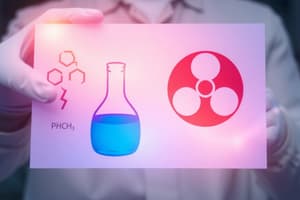Podcast
Questions and Answers
What significance is associated with the presence of epithelial casts?
What significance is associated with the presence of epithelial casts?
- Normal cellular metabolism
- Early signs of dehydration
- Increased glomerular filtration rate
- Advanced tubular destruction (correct)
Which type of calcium oxalate crystal is more commonly observed in urine?
Which type of calcium oxalate crystal is more commonly observed in urine?
- Sulfate
- Phosphate
- Dihydrate (correct)
- Monohydrate
What condition is suggested by the presence of bacterial casts in urine?
What condition is suggested by the presence of bacterial casts in urine?
- Pyelonephritis (correct)
- Nephrotic syndrome
- Chronic renal failure
- Cystitis
What is the appearance of finely granular casts?
What is the appearance of finely granular casts?
What effect do foods high in oxalic acid have on calcium oxalate levels?
What effect do foods high in oxalic acid have on calcium oxalate levels?
Which of the following has a 'cigarette-butt' appearance?
Which of the following has a 'cigarette-butt' appearance?
What are granular casts primarily derived from?
What are granular casts primarily derived from?
Which substance is soluble in acetic acid?
Which substance is soluble in acetic acid?
What is the distinctive characteristic of hemosiderin crystals?
What is the distinctive characteristic of hemosiderin crystals?
Which test indicates a positive result for tyrosyluria/tyrosinemia?
Which test indicates a positive result for tyrosyluria/tyrosinemia?
What type of urine odor is characteristic of tyrosyluria/tyrosinemia?
What type of urine odor is characteristic of tyrosyluria/tyrosinemia?
Which substance can produce crystals mistaken for RBCs?
Which substance can produce crystals mistaken for RBCs?
What is the appearance of acyclovir crystals?
What is the appearance of acyclovir crystals?
Which type of tyrosinemia is associated with the enzyme fumarylacetoacetate hydrolase (FAH)?
Which type of tyrosinemia is associated with the enzyme fumarylacetoacetate hydrolase (FAH)?
What characteristic shape do pollen grains display when observed under a microscope?
What characteristic shape do pollen grains display when observed under a microscope?
What is a false result of fecal contamination in urinary sediment analysis?
What is a false result of fecal contamination in urinary sediment analysis?
What does the presence of blood casts indicate?
What does the presence of blood casts indicate?
How should you report the presence of budding yeast in a specimen?
How should you report the presence of budding yeast in a specimen?
What do the orange-red colored casts likely contain?
What do the orange-red colored casts likely contain?
What is the significance of WBC (leukocyte) casts?
What is the significance of WBC (leukocyte) casts?
Which of the following is true about renal tubular epithelial cells?
Which of the following is true about renal tubular epithelial cells?
What does a high level of bacteria per HPF signify?
What does a high level of bacteria per HPF signify?
What does the presence of squamous epithelial cells in a urine sample indicate?
What does the presence of squamous epithelial cells in a urine sample indicate?
What kind of significance do crystals in urine have?
What kind of significance do crystals in urine have?
What is a common laboratory finding in individuals with Lesch-Nyhan disease?
What is a common laboratory finding in individuals with Lesch-Nyhan disease?
Which test is indicated to show white turbidity in cases of antiglomerular basement membrane disorders?
Which test is indicated to show white turbidity in cases of antiglomerular basement membrane disorders?
What is a distinguishing feature of Wegener's Granulomatosis?
What is a distinguishing feature of Wegener's Granulomatosis?
Which condition is commonly associated with macroscopic hematuria following a viral infection in children?
Which condition is commonly associated with macroscopic hematuria following a viral infection in children?
What type of ANCAs are formed when neutrophils are fixed with ethanol?
What type of ANCAs are formed when neutrophils are fixed with ethanol?
What is an expected clinical feature of Sanfilippo Syndrome?
What is an expected clinical feature of Sanfilippo Syndrome?
Which of the following tests would show a positive blue color indicating the presence of mucopolysaccharides?
Which of the following tests would show a positive blue color indicating the presence of mucopolysaccharides?
What is a key laboratory finding in Henoch Schönlein Purpura?
What is a key laboratory finding in Henoch Schönlein Purpura?
What does a lamellar body count (LBC) greater than 32,000/uL indicate?
What does a lamellar body count (LBC) greater than 32,000/uL indicate?
Which dye characteristic indicates the presence of surfactant when measured?
Which dye characteristic indicates the presence of surfactant when measured?
What is the primary composition of sputum?
What is the primary composition of sputum?
Which method can be used to determine the lamellar body count (LBC)?
Which method can be used to determine the lamellar body count (LBC)?
What is the significance of an O.D. (Absorbance) greater than 0.150?
What is the significance of an O.D. (Absorbance) greater than 0.150?
What is NOT a characteristic of sputum?
What is NOT a characteristic of sputum?
Which component is the most important for sputum viscosity?
Which component is the most important for sputum viscosity?
What is the acceptable white blood cell count in a sputum specimen?
What is the acceptable white blood cell count in a sputum specimen?
What condition could lead to false-positive results in a pregnancy test?
What condition could lead to false-positive results in a pregnancy test?
Which hormone is primarily produced by the syncytiotrophoblast cells of the placenta?
Which hormone is primarily produced by the syncytiotrophoblast cells of the placenta?
At what stage of pregnancy does hCG typically peak?
At what stage of pregnancy does hCG typically peak?
What method is commonly used for the collection of specimens for genetic defect assessment during the 2nd trimester?
What method is commonly used for the collection of specimens for genetic defect assessment during the 2nd trimester?
Which of the following is NOT a typical cause of false-negative pregnancy tests?
Which of the following is NOT a typical cause of false-negative pregnancy tests?
What is the cut-off point for a positive result in home-based hCG pregnancy tests?
What is the cut-off point for a positive result in home-based hCG pregnancy tests?
Which of the following tests is performed to assess fetal lung maturity?
Which of the following tests is performed to assess fetal lung maturity?
What should be done with specimens for cytogenetic studies immediately after collection?
What should be done with specimens for cytogenetic studies immediately after collection?
Which condition can lead to urinary tract deformities in a fetus?
Which condition can lead to urinary tract deformities in a fetus?
Which of the following is not a component of the quadruple screening test?
Which of the following is not a component of the quadruple screening test?
Flashcards
Epithelial Cells (urine)
Epithelial Cells (urine)
Cells present in urine from lining of tubules or other parts of the urinary system. Their presence and quantity varied. It is quantitated by per LPF (low power field).
WBC Cast
WBC Cast
Cylindrical structures in urine composed of white blood cells, indicating inflammation or infection in kidney's nephron region.
RBC Cast
RBC Cast
Cylindrical structure in urine containing red blood cells., indicating bleeding within the nephron region.; Quantitated by quantity per HPF (high power field).
Significance of casts (urine)
Significance of casts (urine)
Signup and view all the flashcards
Blood Casts (urine)
Blood Casts (urine)
Signup and view all the flashcards
Bacteria in urine
Bacteria in urine
Signup and view all the flashcards
Renal Tubular Epithelial Cells
Renal Tubular Epithelial Cells
Signup and view all the flashcards
Pseudoleukocyte Cast
Pseudoleukocyte Cast
Signup and view all the flashcards
Epithelial Casts
Epithelial Casts
Signup and view all the flashcards
Calcium Oxalate Casts
Calcium Oxalate Casts
Signup and view all the flashcards
Bacterial Casts
Bacterial Casts
Signup and view all the flashcards
Granular Casts
Granular Casts
Signup and view all the flashcards
Calcium Oxalate Monohydrate
Calcium Oxalate Monohydrate
Signup and view all the flashcards
Calcium Oxalate Dihydrate
Calcium Oxalate Dihydrate
Signup and view all the flashcards
Glomerulonephritis
Glomerulonephritis
Signup and view all the flashcards
Tubular Destruction
Tubular Destruction
Signup and view all the flashcards
Hemosiderin crystals
Hemosiderin crystals
Signup and view all the flashcards
Acyclovir crystals
Acyclovir crystals
Signup and view all the flashcards
Indinavir Sulfate crystals
Indinavir Sulfate crystals
Signup and view all the flashcards
Starch granules in urine
Starch granules in urine
Signup and view all the flashcards
Oval fat bodies
Oval fat bodies
Signup and view all the flashcards
Fatty casts
Fatty casts
Signup and view all the flashcards
Oil droplets
Oil droplets
Signup and view all the flashcards
Tyrosyl/Tyrosinemia
Tyrosyl/Tyrosinemia
Signup and view all the flashcards
Sanfilippo Syndrome
Sanfilippo Syndrome
Signup and view all the flashcards
Lesch-Nyhan Disease
Lesch-Nyhan Disease
Signup and view all the flashcards
Acid Albumin Test
Acid Albumin Test
Signup and view all the flashcards
CTAB Test
CTAB Test
Signup and view all the flashcards
Mucopolysaccharide Paper Test
Mucopolysaccharide Paper Test
Signup and view all the flashcards
Wegener's Granulomatosis
Wegener's Granulomatosis
Signup and view all the flashcards
Henoch-Schönlein Purpura
Henoch-Schönlein Purpura
Signup and view all the flashcards
ANCA
ANCA
Signup and view all the flashcards
Sputum
Sputum
Signup and view all the flashcards
Bronchoalveolar Lavage (BAL)
Bronchoalveolar Lavage (BAL)
Signup and view all the flashcards
Surfactant to Albumin Ratio (S/A)
Surfactant to Albumin Ratio (S/A)
Signup and view all the flashcards
Lamellar Body Count (LBC)
Lamellar Body Count (LBC)
Signup and view all the flashcards
What does a high LBC indicate?
What does a high LBC indicate?
Signup and view all the flashcards
OD 650 nm
OD 650 nm
Signup and view all the flashcards
What does a high OD 650 nm indicate?
What does a high OD 650 nm indicate?
Signup and view all the flashcards
Acceptable Sputum Specimen
Acceptable Sputum Specimen
Signup and view all the flashcards
hCG function
hCG function
Signup and view all the flashcards
hCG structure
hCG structure
Signup and view all the flashcards
hCG pregnancy test
hCG pregnancy test
Signup and view all the flashcards
False-positive hCG
False-positive hCG
Signup and view all the flashcards
False-negative hCG
False-negative hCG
Signup and view all the flashcards
Amniocentesis
Amniocentesis
Signup and view all the flashcards
Amniotic fluid testing
Amniotic fluid testing
Signup and view all the flashcards
Quadruple screening
Quadruple screening
Signup and view all the flashcards
Fetal lung maturity (FLM)
Fetal lung maturity (FLM)
Signup and view all the flashcards
Specimen handling (amniotic fluid)
Specimen handling (amniotic fluid)
Signup and view all the flashcards
Study Notes
Biological Hazards
- Potentially harmful organisms can be transmitted through a cycle of infection
- This cycle requires a source, mode of transmission, and susceptible host
- Preventing infection requires breaking this chain, focusing on personal protective equipment (PPE) and proper hand hygiene
- Components of the infection cycle: infectious agent, reservoir, portal of exit, mode of transmission, portal of entry, and susceptible host
Sharp Hazards
- Sharp objects (needles, lancets, broken glass) should be disposed of in puncture-resistant containers
- Workers should carry puncture-resistant containers
- Accidental needle-stick incidents must be reported to supervisor
Chemical Hazards
- Chemical spills should be flushed with large amounts of water for 15 minutes followed by seeking medical attention
- Never neutralize chemicals on skin
- Acid spills should be neutralized then soaked up with wet rags or spill pillows
- Always add acid to water, not water to acid, to prevent splashing
Radioactive Hazards
- Procedures involving radioisotopes require precautions against radiation exposure
- Radioactive waste should be stored in a secure, marked room until its radioactivity decays to a safe level
Fire/Explosive Hazards
- Flammable substances should be stored in safety cabinets or explosion-proof refrigerators
- Laboratory personnel should participate in annual fire drills
- Actions to take if a fire is discovered: rescue, alarm, contain, extinguish/evacuate
Electrical Hazards
- Do not operate electrical equipment with wet hands
- All electrical equipment should be grounded
- If an electrical shock occurs, turn off the power, unplug the equipment and move the equipment using a nonconductive object
Miscellaneous Hazards
- Ergonomic hazards are related to repetitive movements or positions
- Cryogenic hazards are related to extremely low temperatures
- Mechanical hazards related to equipment (centrifuges, refrigerators) and broken glassware
- Aerosols can be formed from centrifuge accidents
Studying That Suits You
Use AI to generate personalized quizzes and flashcards to suit your learning preferences.




